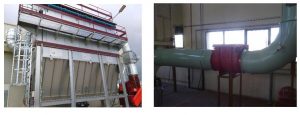20 years of experience at your service in protection
consulting and training in Explosive Atmospheres
Added to cart
There are no products in the basket
E-BOOK-VERSION – DOWNLOAD HERE
In the industry, there are facilities with raw material reception systems, such as grain handling facilities, breweries, feed mills or the food industry, among others.
In this part of the facility, the reception, cleaning, conveying and storage of the raw material, which will later be used in the corresponding production process, takes place.
Generally, a raw material reception system consists of the following elements:
The goal of this article is to assess the two types of equipment with the highest risk of explosion, which are also considered to be the most hazardous in terms of serious consequences, namely baghouses and bucket elevators.

Baghouse after explosion
Explosion risk assessment
A proper explosion risk assessment must cover both the likelihood of explosive atmospheres occurring (ATEX zone classification), as well as any ignition sources which may arise in the equipment and which may ignite such explosive atmospheres.
The implementation of reputable international standards is always advisable in order to properly assess the risk of explosion and therefore justify the necessary measures to mitigate such risk. These standards include the European standards EN 60079-10-2 (for the classification of areas in explosive dust atmospheres), and EN 1127-1 (explosion prevention and protection); the German standard VDI 2263 for the assessment of explosion risks in bucket elevators or baghouses; the technical report CEN/TR 16829 on prevention and protection in bucket elevators; as well as the NFPA standards.
As the design of a proper assessment plan regarding explosion risks in the abovementioned equipment is dealt with in other articles written on the subject (see https://adixatex.com/recursos/), it can be summarised as follows:

Example of ATEX zone classification in a baghouse filter
Recommended preventive and protective measures
Adix, along its suppliers, has designed and developed a series of explosion prevention and protection systems in accordance with the specific requirements of the ATEX Directive 2014/34/EU and the corresponding harmonised standards, intended for their installation in equipment such as those analysed in this article and which represent an added value to systems, as prevention and protection against the risk of explosion must be considered an investment in safety. Adix can provide the following solutions to address the risk of explosion in this type of equipment:
As stated in Directive 1999/92/EC, the priority of an efficient strategy to avoid the risk of explosion is to prevent an explosion from occurring, either by preventing the formation of a possible explosive atmosphere or by preventing the formation of an ignition source if the former cannot be achieved. There are a number of preventive measures that can be implemented in baghouses and bucket elevators:
The main advantage of this type of system is how easy it is to install and implement in the equipment (as it is minimally invasive), as well as to maintain, although it is necessary to dispose of water supply with minimum pressure conditions for extinguishing.

Spark detection and shutdown system
It is a flexible system that facilitates the proper and simple control of an elevator. It is also fully configurable, but it requires proper maintenance for smooth operation.
If the risk assessment determines that the risk of explosion cannot be eliminated by implementing preventive measures alone, explosion protective measures should also be implemented to protect both facilities and workers against the consequences of an explosion. For baghouses and bucket elevators there are a number of protective measures that can be implemented:
The installation of vent panels on baghouses and bucket elevators is one of the easiest protective measures to implement, as it is easy to install and adapts well to equipment. Besides, it also requires low maintenance. However, it is not always possible to implement this type of protection, in which cases another type of protection system should be taken into account.
The installation of a suppression system is an effective measure that is easy to use by means of its built-in control system. However. its performance depends on the correct periodic maintenance indicated by the manufacturer.
Check valves are easy to install and maintain and, additionally, they are a proven solution against explosion propagation. However, they have process requirements derived from certification tests on maximum air velocity in the line (20 m/s) and dust concentration (<500 g/m3), and must always be used together with a protection system (explosion vent).
The installation of a chemical isolation system, as in the case of suppression systems, is an effective measure that is easy to use by means of its built-in control system. However. its performance depends on the correct periodic maintenance indicated by the manufacturer.
Note: The implementation of protection systems should follow a reputable standard or guideline (e.g. EN 14491, CEN/TR 16829 or NFPA 68).

Protection systems (vent panel and flap valve) in baghouse (source: ADIX)
E-BOOK-VERSION – DOWNLOAD HERE
20 years of experience at your service in protection
consulting and training in Explosive Atmospheres
Personalized assistance in more than 30 countries.
Our customer service works to offer you the best solution.
Shipping. For more information here
Worldwide shipping.
Insurance included and return guarantee
Ask our sales team without obligation.
News on your company's protection
Be the first to know when new products are launched and get significant discounts
